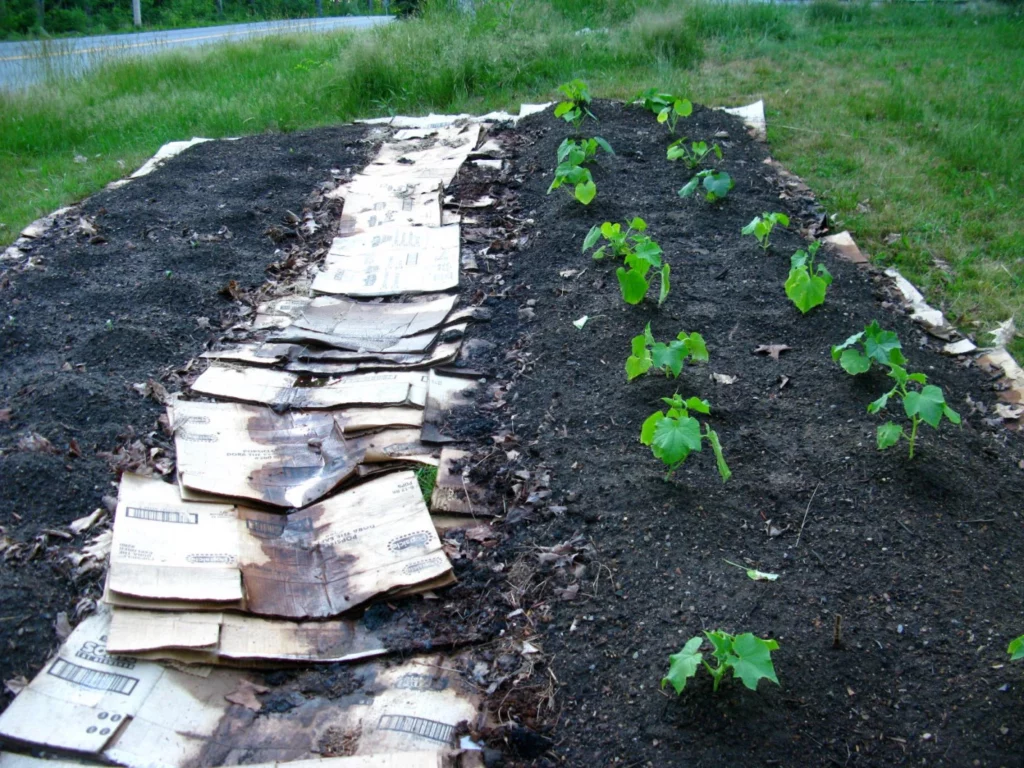No-Dig’ or ‘No-Till’ is a soil-friendly method from permaculture. Without much intervention, prior knowledge or effort, you can create a no-dig bed, also called a lasagna bed. This method works with natural control cycles. So you can create new beds without digging and improve the soil in the process. In this article you will find an answer to why you should not dig up your garden soil or in which exceptions it can be useful. In addition, we explain how you can create a no-dig bed and what to consider.
Advantages of No-Dig:
- Promotion and activation of soil life
- Improvement of the soil structure and protection of the soil structure
- Suppression of weeds
- Higher yields
- Less physical labor and time
Exceptions:
- in heavy soils
- with deep soil compaction (Dutchmen)
Contents
- 1 Create a no-dig bed
- 2 Soil-friendly alternative to digging
- 3 No-Dig: Planting beds without digging over them
- 4 Gardening without digging for fertile soil.
- 5 Advantages of the No-Dig method
- 6 Suppression of weeds
- 7 Higher yields
- 8 Less physical work & effort
- 9 Sustainable
- 10 Soil-friendly gardening with the No-Dig method.
- 11 Maintain and improve soil structure
- 12 Preserving and promoting soil life
- 13 Important helpers in the soil
- 14 The more earthworms, the better!
- 15 Soil is a community of numerous organisms
- 16 No-Dig as an alternative to digging beds.
- 17 How it works: Create no-dig beds
- 18 Plant lasagna bed
- 19 Plant high-yielding plants
- 20 Digging around can also be useful
- 21 For deep soil compaction
- 22 Author
Create a no-dig bed
- Select area & water
- Lay down insulating layer of cardboard & wait one week
- Apply alternating layers of brown & green material
- Mulch
- No-dig method: gardening with nature
Japanese microbiologist and farmer Masanobu Fukuoka developed the philosophy of “no-dig farming.” This is based on the assumption that nature can sustain itself without any human intervention. All man has to do is leave nature to its own devices. After years of observing his garden, he developed several permaculture methods. The No-Dig method is based on Fukuoka’s concept of natural and ecological agriculture with natural self-regulating cycles. The Englishman Charles Dowding developed, applied and spread the No-Till method in our latitudes.
Soil-friendly alternative to digging
With little investment of time and resources, anyone can grow and harvest fruits and vegetables in their own garden. The goal is to reclaim existing vegetation and create new beds in a way that is gentle on the soil. Even areas in your garden with moderate to poor soil quality or contamination can be “revitalized” in this way. In addition, this method is also suitable for areas where digging is not possible, such as a meadow with dense turf or a lawn.
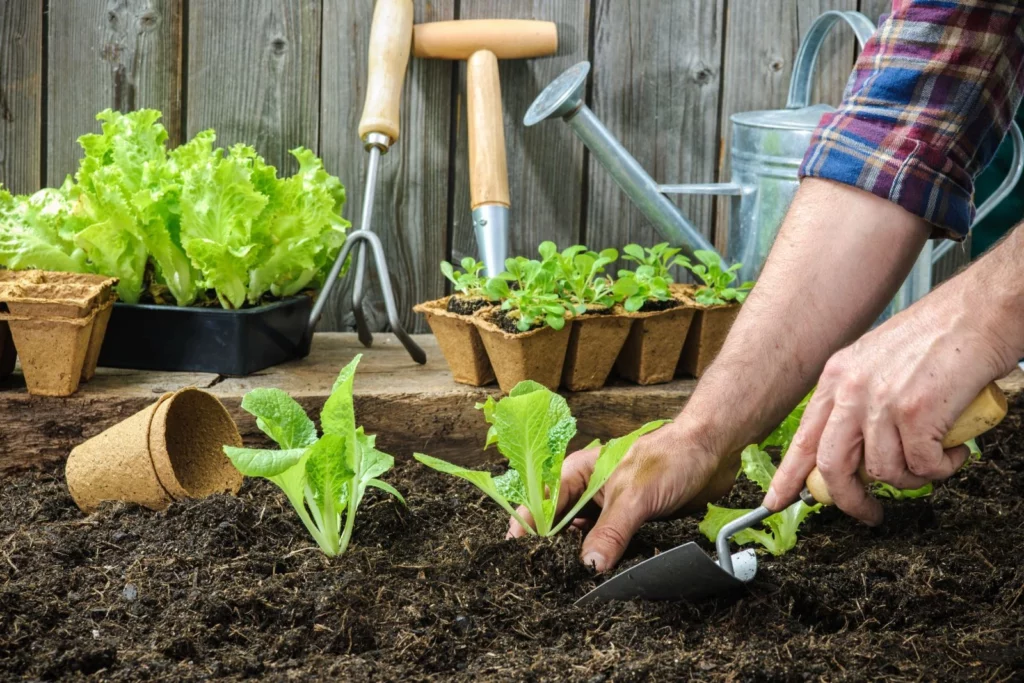
No-Dig: Planting beds without digging over them
In the No-Dig method, gardeners avoid digging when creating new beds or working on existing ones. Instead of digging, new beds are created using sheet mulching. This involves placing various layers of organic material directly on the bed instead of digging it up. Amateur gardeners therefore call such beds lasagna beds. This approach follows the principles of regenerative agriculture and focuses on working in a way that is gentle on the soil, thus preserving and promoting soil fertility and life.
Gardening without digging for fertile soil.
A humus-rich, fertile soil can store more plant-available water and nutrients. This is because the conversion of organic materials to humus creates stable humus aggregates that give the soil a good crumb structure. With such a stable structure, the soil is better protected against wind and water erosion. In addition, there is a regular resupply of plant-available nutrients that are released during the conversion of organic matter and humus.
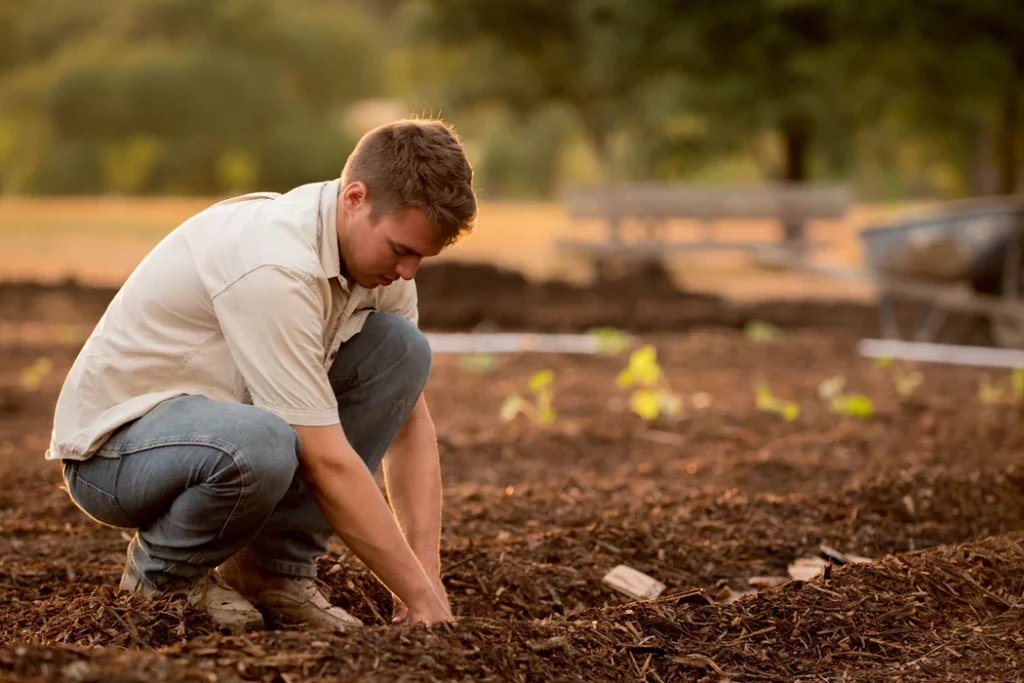
Advantages of the No-Dig method
Promotion of soil life and biological activity
With sheet mulching, you provide a real feast for the microcosm in the soil. Biological activity increases because all the organic material is converted.
Protection of the soil structure and improvement of the soil structure
The sensitive soil structure is preserved and the biological activity increases. A loose crumb structure is created by humus build-up and decomposition. The improved soil structure in turn has a positive effect on the water and nutrient holding capacity and thus on the crop plants.
Suppression of weeds
By piling up new organic matter, existing vegetation is cut off from light and dies. In addition, virtually nothing grows through the first layer of cardboard. Only from the sides could wild weeds establish themselves on the surface, or the seeds reach the new surface through the wind.
Higher yields
Due to improved soil conditions, plants find good growing conditions. In addition, high biological activity leads to increased heat buildup in the soil, which benefits plant growth in the spring.
Less physical work & effort
With the no-dig method, you get around the strenuous and time-consuming digging up. Not only does it give you more time to do other things, but it’s also easy on your back. No matter where – on the balcony or in the garden, on good or bad soil. This method allows you to place a bed anywhere. And with hardly any investment of time, money or effort.
Sustainable
No-dig beds are sustainable and good for the environment in many ways. In addition to keeping the soil healthy, you can also reuse any garden waste that is generated and put it back into the cycle.

Soil-friendly gardening with the No-Dig method.
Soil develops through various physical and (bio)chemical processes. The site-specific parent rock weathers and as it breaks down, smaller and smaller particles and mineral nutrients are produced. In addition, the organic material decomposes, for which the numerous soil organisms work together. In fact, the soil is home to numerous living organisms of various sizes – the edaphon. In addition to large organisms such as moles, voles and earthworms, an extremely large number of microscopic creatures also live in our soil. Up to 10 billion organisms can live in one liter of soil! It is diligently crushed and mixed until this cooperation creates stable humus aggregates and a soil structure. The fertility of the soil is not only vital for these living organisms, but also forms our basis of life. In order not to endanger soil life and thus soil health and to manage our fields sustainably, gardeners must pay attention to the needs of the soil!
Maintain and improve soil structure
Digging up the garden soil is a common practice, but unfortunately it has one very big disadvantage: Digging up destroys the natural layering of the soil and upsets its structure. By tilling in a way that is gentle on the soil, the soil structure and stratification are preserved and the sensitive balance in the soil remains intact.
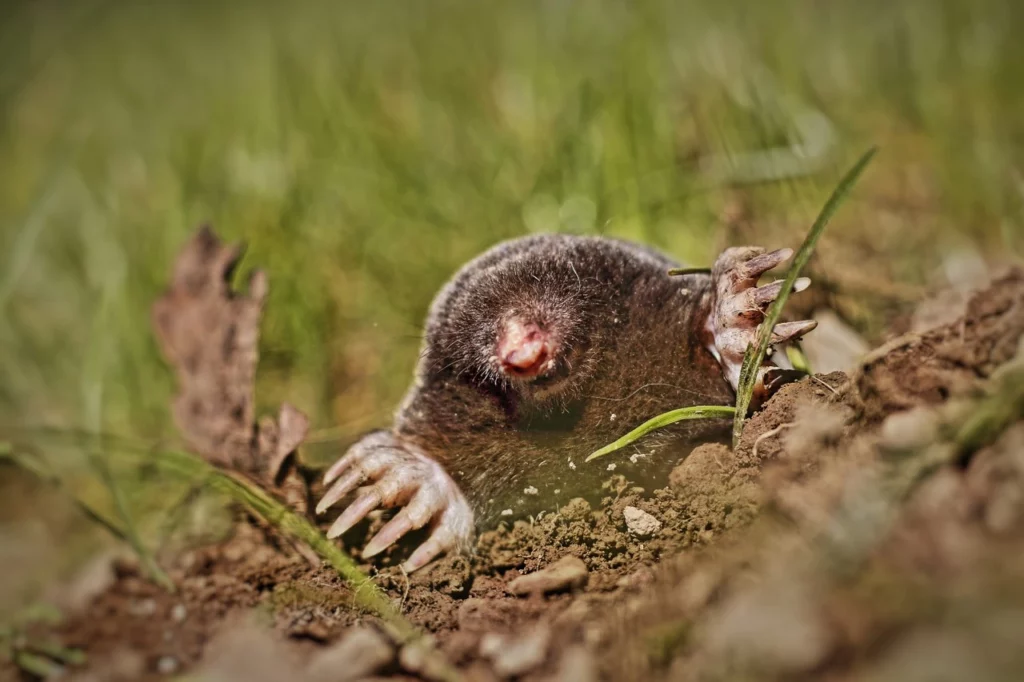
Preserving and promoting soil life
When digging, the soil life is literally turned upside down. Lower layers come to the surface while the upper layers are buried. However, the small creatures are perfectly adapted to their habitat: Oxygen-loving species live on the surface and species that need it moist and low in oxygen live in deeper layers. When you dig up the soil, you move all these organisms to a place where conditions are not optimal for them. The soil organisms first have to reorient themselves, and some even die. This destroys the natural, finely tuned soil structure and inhibits biological activity and transformative processes in the soil (humus formation and decomposition). The conversion of organic matter to humus is slower and there is mineralization of mobile nutrients that are prone to leaching. To maintain the natural function of the soil to convert organic matter, you can use the No-Dig method. Here you stimulate the biological activity in the soil by providing food through the piled organic material.

Important helpers in the soil
Soil is a community of numerous living organisms: Bacteria, fungi, protozoa, nematodes, springtails, isopods, earthworms and co. This community forms a soil food web that is finely tuned to each other. Biological activity is strongly related to the way of gardening. This is because tillage can disrupt soil life, but vegetation cover and its diversity also play an important role.
Bacteria and fungi are at the beginning of the soil food web.
These tiny organisms feed partly on organic matter and to a large extent on plant root exudates. Therefore, most bacteria also live in the part of the soil where the roots grow (=rhizosphere). Their activity and existence is much related to the existing vegetation at a site. A plant cover that is as diverse as possible is good here, because then the soil life is also more diverse. There are inhabitants with different responsibilities: Decomposers (e.g. actinomycetes), mutualists (e.g. nodule bacteria, mycorrhiza), pathogens and other bacteria that do not feed on organic matter. In addition, the small soil inhabitants are in turn food for protozoa such as amoebae and ciliates, as well as earthworms. Thus, the soil food web begins and continues from the microcosm to the macrocosm of the soil. For this reason, it is enormously important that you have enough microorganisms in the soil so that the soil food web has a foundation and biological processes can take place.
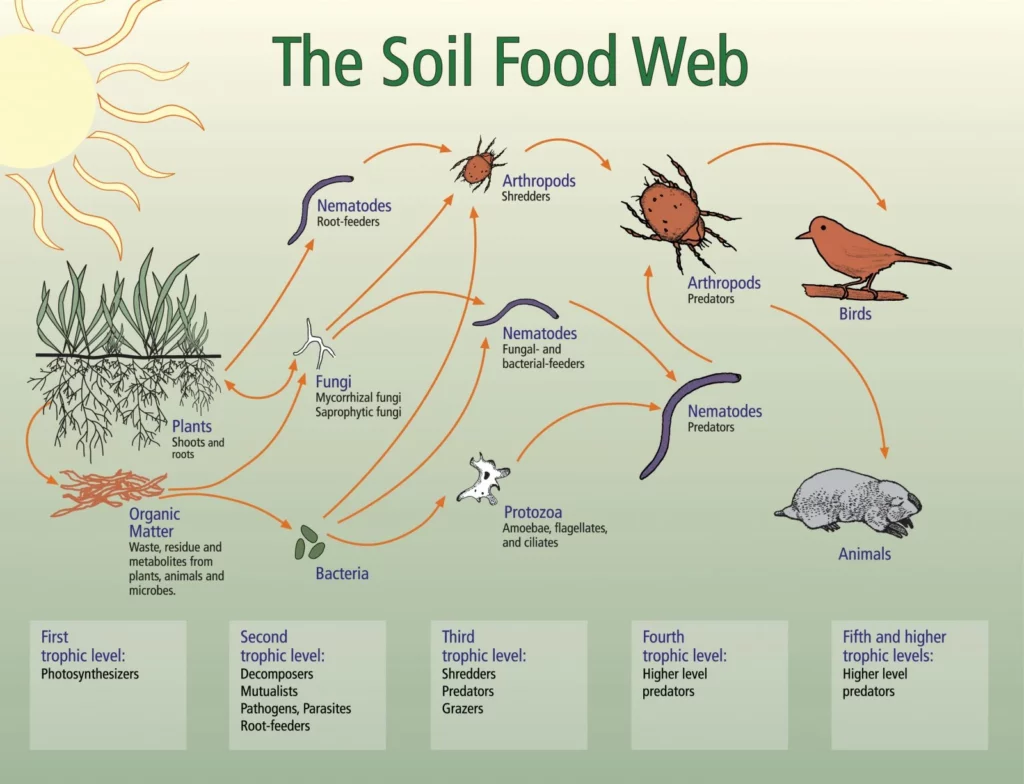
The more earthworms, the better!
The earthworm is also a soil dweller that is very sensitive to tillage. It is a valuable helper in the garden, which is significantly involved in the decomposition of organic matter at many locations. The number of earthworms in the soil can be used to assess how healthy the soil is. They dig deep burrows in the soil, mixing and metabolizing organic matter, contributing to a loose crumb structure. Air and water channels are created with the tunnels, which improves water and air balance in the soil. With the no till method, you encourage earthworms to do the digging for you.
Soil is a community of numerous organisms
There are an enormous number of other organisms in the soil that in turn contribute to soil function and the soil food web. The above are just two examples of many. Soil is a super complex system where research is also just beginning. But to garden in a soil-friendly way, you should understand basic relationships and consider the soil in its entirety.
No-Dig as an alternative to digging beds.
The foundation of a healthy and productive garden is fertile soil. This in turn depends on soil life – from bacteria to earthworms that convert organic matter. Where there is organic material, there are living things that convert it and make it usable for us. It’s the same principle as compost. With sheet mulching, you’re using that knowledge. However, the process of composting takes place directly on the bed. By layering different organic materials, composting is triggered. When layering, you alternate between nitrogen-rich material (green layer) and carbon rich material (brown layer). With a little patience, a wonderfully revitalized garden with fertile beds will result.
How it works: Create no-dig beds
Material
You will need some organic materials for the layers of the lasagna bed. For the brown layer you can use straw, wood chips, reeds, leaves, pine needles, leaves and other small chopped wood and branches from your garden. If you have some cardboard left over, you can also use it for the brown layer. But it should be unprinted and free of tape. Otherwise you run the risk of contaminating the soil with heavy metals from the printing ink or microplastics from the tape. For the green layer, manure, grass and vegetable clippings, coffee grounds, compost, vegetables, fruit, tea leaves, tea bags and wild herbs are all suitable. Wild herbs, such as nettles speed up decomposition and are rich in valuable nutrients.
Instructions
- Identify an area. Preferably one that needs soil improvement or is weedy. Mow this area and level it. If it is particularly dry, water thoroughly. This will help the composting process. Optionally, you can add a thin layer of compost to the turf as a starter.
- The first layer is an insulating layer of hard-to-decompose material. It serves as a kind of barrier to sunlight and prevents existing vegetation from growing. Unprinted cardboard is suitable for this purpose. But be careful. – The first layer of insulation should not be too thick, otherwise it can lead to oxygen-deficient conditions in the soil. The soil organisms need oxygen to decompose the materials. After you have applied the first layer, you should therefore wait about a week before applying further layers.
- Now apply alternating layers of brown and green organic materials to the cardboard. I have listed above which materials are suitable for this. As a rule of thumb you can remember: The brown layers should be about twice as high as the green layers.
- Through the process of decomposition, the layers lose volume. You should keep this in mind when planning. The layers should be at least twice as high as the future bed. If you want to start planting directly, you should add a layer of garden soil about 15-20 cm high.
- Finally, lay a mulch layer of straw, grass clippings, bark mulch or chopped leaves on the bed. Make sure that there is always a layer of mulch. This will protect the bed from unwanted weeds and from drying out.
Plant lasagna bed
Refrain from nitrate-enriching crops
Have you decided to plant your bed right away? Then there are a few things to keep in mind when choosing crops to start with. Decomposition releases large amounts of nitrate into the soil. Therefore, during the decomposition process (first 1-2 years), you should avoid growing nitrate-enriching plants. These include spinach, radishes, radishes and lettuce. Especially with leafy vegetables, harmful amounts of nitrate can be stored in the leaves.
Plant high-yielding plants
That’s why high-yielding plants such as cucurbits, tomatoes or cabbage are better suited here for starters. These crops enjoy an extra dose of nitrogen and thrive better. After about one season, depending on the height of the lasagna bed, everything will have decomposed and the cultivation of low-yielding or even nitrate-enriching plants is safe. To plant the lasagna bed also according to the principles of permaculture, you can use a mixed culture.
There is this to consider:
- Microorganisms need oxygen to decompose layers of organic material. Make sure your lasagna bed has an adequate supply of oxygen. It is important to wait a week after placing the insulation layer. This way you make sure that their decomposition has already started and there is enough oxygen on the soil surface. Otherwise, you will attract unwanted microorganisms that will cause rotting.
- Moisture is important for composting. If there is a drought, you should water the lasagna bed adequately. The mulch layer also helps prevent moisture loss.
- Check regularly to make sure the bed is free of unwanted wild weeds. A layer of mulch can help here, too. If a weed or two does make it through the insulating layer, weed it out by hand.
- Often other garden inhabitants such as slugs and ants are attracted to leaf mulching. This is beneficial to the composting process. Later, when the area is used as a bed, they can become a problem. A slug fence can help with this. Other garden pests such as voles also feel particularly at home in a lasagna bed. An overview of plant pests in the garden and their control can be found in our article.
- At the beginning, different layers of organic matter are layered. Until this material is converted by soil organisms, it takes a little time. Therefore, the bed is initially not very deep and not suitable for particularly deep-rooted plants or root vegetables. It takes a few months for a loose crumb structure to develop. If you want to create a bed quickly, you can create your own raised bed. Alternatively, you can build them a raised bed. You can find an example of a planting plan for a mixed culture with root vegetables in our article on the subject.
Digging around can also be useful
For heavy soils
Heavy clay or loam soils are characterized by a very fine soil structure with many small pores. The problem here is that the water is fixed in the small pores and is not available to plants. For this, the crumb structure must become more coarse-pored. In this case, one-time digging can be useful when planting. The best time is in late autumn before the first soil frosts. The soil can benefit from the frosts: During frost heave, existing soil aggregates are broken up by the frozen water, creating more air voids. This creates a comparatively loose, fine-textured bed. In very heavy soils, it may be worthwhile to add a little sand to the top layer that has been dug over. After digging, the bed should not lie open. Otherwise, weeds will grow and the soil will be at risk of erosion and silting. To further improve the soil structure and so that the soil is not so bare, you can now create a lasagna bed on top of it.
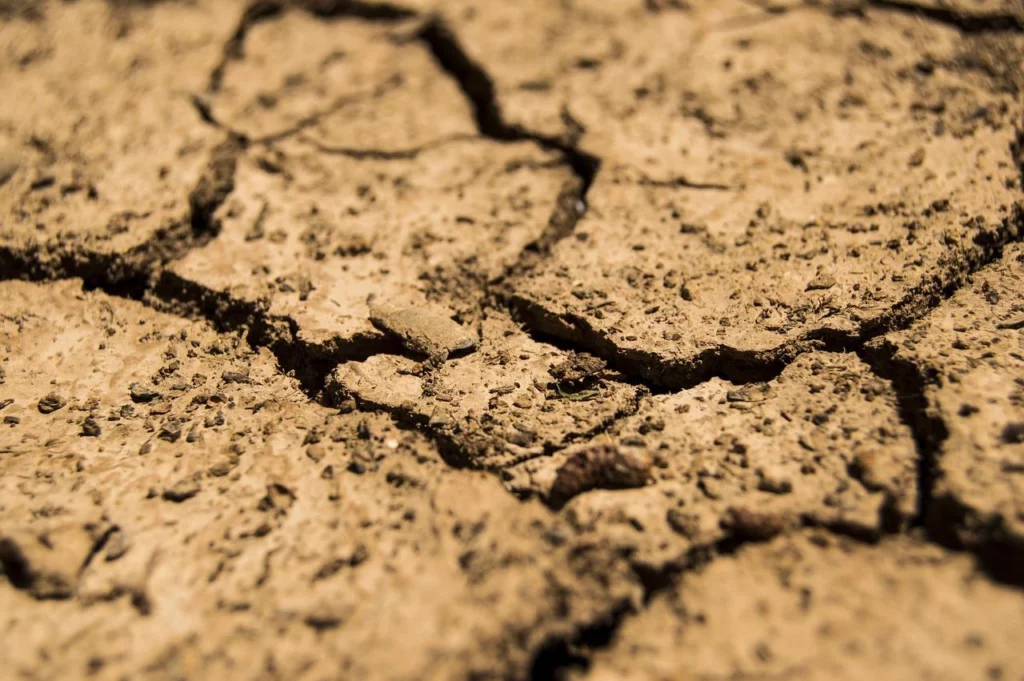
For deep soil compaction
Soil compaction can have a wide variety of causes: heavy machinery (plow bottom), silting due to insufficient soil structure, etc.
In the case of severe soil compaction, this horizon acts like a blockade. Plant roots cannot grow further here and this becomes a problem especially for deep-rooted crops. Here, the compaction horizon can only be broken up by digging.

